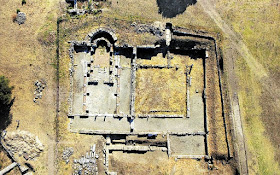Much ink has been spilled on the promising excavations of Kasta Hill at a short distance from the town of Amphipolis proper. For that reason, the importance of this city harbor has been seriously neglected.
Amphipolis was an Athenian colony founded in the 5th century BC. It was surrounded by a 7.5-kilometer-long wall, probably dating from the Classical Period, but the date has not been confirmed yet. It would be interesting though, to know whether Philip II had attacked it in 356 BC when he ousted the Athenians in power. Amphipolis was key to the king’s conquest because it sat on the mouth of the Strymon River which gave him access to the mines of Crenides (later renamed Philippi) and opened up the trading route with Thracia (see: Macedonia’s gold and silver mines today).
When Alexander set out from Pella towards Asia in 334 BC, he crossed the bridge of Amphipolis (see: Bridge of Amphipolis used by Alexander), which was constructed at some time between 600 and 550 BC and was first mentioned in history during the Peloponnese War of 422 BC.
The city has a lot to tell us, as the occasional photographic and on-site research reveals. However, the archaeologists seek financial support to establish what Amphipolis looked like in the days of Alexander and how it changed by the time Philip V died here in 179 BC. So far, it has been recorded that the city possessed a well-preserved Gymnasium and the remains of a Hellenistic house with frescoed walls.
At present, special
attention is given to the Acropolis of Amphipolis located within sight of Kasta Hill. Scholars tell us that it becomes easy to understand the city's importance as
this location gave its citizens full control over the Strymon
River, the gateway to the sea and Crenides, and the overland route into
In the past two years, archaeologists have concentrated on the Acropolis, whose inner walls were exposed in the 1960s and 1970s. Otherwise, there is a lot of architectural debris lying around. At the same time, other parts have been reused by the Romans to rebuild the city’s fortifications. The same applied to the Christians when they built their monuments. These public buildings stand on top of older layers, and the current five-year plan (2019-2023) will concentrate on the pre-Christian Acropolis.
The bottom line is that we still need more patience before establishing a solid link with Alexander in the early days of his kingship.


No comments:
Post a Comment